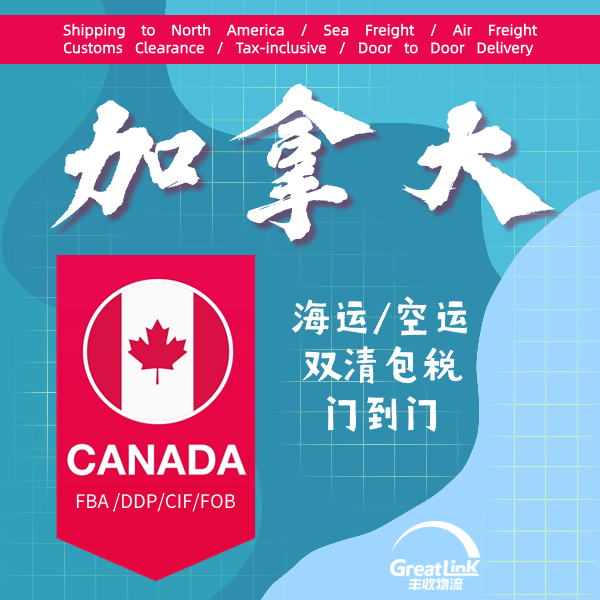How to choose the best way to ship to Canada
 2023-12-28
2023-12-28
 603
603
Shipping is an economical international logistics mode, which is suitable for transporting large quantities, heavy and unnecessary goods. However, there are different ways of shipping, such as port-to-port, door-to-door, door-to-port, etc. Different ways have different advantages and disadvantages, so customers should choose the appropriate way according to their own needs and budget. This article introduces two common ways of shipping to Canada: port-to-port and door-to-door, and their features, processes, and considerations.

Port to Port:
Port-to-port means that goods are transported from the departure port of China to the destination port of Canada, and customers need to be responsible for loading, customs declaration, customs clearance, tax payment, delivery and other matters. The advantage of this method is that the freight is relatively low, but the disadvantage is that customers need to spend more time and energy on various procedures, and they also need to bear risks and responsibilities.
The shipping process from port to port is as follows:
Customers choose the right shipping company and route, book shipping space and pay deposit.
The customer arranges the cargo to be loaded into the container, fills in the cargo list, contacts the Inspection and Quarantine Bureau for fumigation and stamping, and then delivers the container to the departure port.
Customers entrust customs declaration company to carry out EXP customs declaration, provide goods list, invoice, contract, bill of lading and other information, and pay customs declaration fees.
The goods are boarded at the port of departure, the shipping company issues a bill of lading, and the customer pays the balance and gets the bill of lading.
After a period of sailing, the goods arrive at the destination port, customers need to contact the customs clearance company in advance, provide bills of lading, invoices, contracts and other information, and pay customs clearance fees.
Customs clearance companies perform import clearance on behalf of customers, pay customs duties and value-added tax, and wait for customs release.
After customs release, customers need to pick up the goods within the specified time, otherwise they need to pay the storage fee.
After customers pick up the goods, they need to arrange their own transportation and Break bulk to complete the shipping.
Precautions for port-to-port shipping are as follows:
Customers need to know the regulations and requirements of the destination port in advance, such as whether to provide Certificate, whether to carry out quarantine, whether to pay environmental protection tax, etc., so as to avoid unnecessary troubles and delays.
Customers need to ensure that the packaging and labeling of goods meet international standards, such as fumigation and stamping if using wooden packaging, otherwise they may be rejected by customs or fined.
Customers need to carefully check the contents of the bill of lading, such as the name, Quantity, weight, volume, POD, etc., so as to avoid errors or omissions, which will affect customs clearance and delivery.
Customers need to track the transportation status of goods in time, such as whether they have boarded the ship, arrived in POD, cleared customs, etc., so as to deal with possible problems in time.
Door to door:
Door-to-door means that goods are transported from Chinese departure place to Canadian destination. Customers do not need to handle any formalities by themselves, but only need to provide goods list and receiving address. Logistics companies are responsible for the whole service, including packing, customs declaration, customs clearance, tax payment, delivery, transportation, Break bulk, etc. The advantage of this method is that customers are more worry-free, time-saving and labor-saving, while the disadvantage is that the freight is relatively high, and customers need to trust the professionalism and quality of logistics companies.
The door-to-door shipping process is as follows:
The customer chooses the appropriate logistics company, provides the goods list and receiving address, and the logistics company gives the freight quotation and transportation scheme according to the weight, volume and name of the goods, and the customer confirms and pays the deposit.
The logistics company arranges the trailer driver to pick up the container at the dock in advance, arrive at the customer's departure place on time, assist the customer in loading the container, fill in the cargo list, contact the Inspection and Quarantine Bureau for fumigation and stamping, and then send the container to the departure port.
The logistics company entrusts the customs declaration company to carry out EXP customs declaration, provide goods list, invoice, contract, bill of lading and other information, and pay customs declaration fees.
When the goods are boarded at the port of departure, the shipping company issues a bill of lading, and the logistics company pays the balance and gets the bill of lading.
After a period of sailing, the goods arrive at the destination port, and the logistics company contacts the customs clearance company in advance, provides bills of lading, invoices, contracts and other information, and pays the customs clearance fees.
Customs clearance companies perform import clearance on behalf of customers, pay customs duties and value-added tax, and wait for customs release.
After the customs release, the logistics company arranges personnel to pick up the goods, transport them to the customer's destination, assist the customer in Break bulk, collect the balance and complete the shipping.
Precautions for door-to-door shipping are as follows:
Customers need to choose a qualified and reputable logistics company. If necessary, they can check the business license, customs declaration qualification and transportation insurance of the logistics company, so as to avoid the loss or delay of goods caused by bad logistics companies.
Customers need to sign a formal contract with the logistics company to clarify the rights and obligations of both parties, such as freight, transportation time, compensation liability, etc., so as to have legal basis when problems arise.
Customers need to ensure that the name, Quantity, weight and volume of goods are consistent with the goods list, otherwise it may lead to differences in customs declaration, customs clearance and tax payment, which will affect transportation and receipt.
Customers need to communicate with logistics companies in time to know the transportation status of goods, such as whether they have boarded the ship, whether they have arrived in POD, whether they have cleared customs, etc., so as to arrange receiving goods in time.
Summarize
There are different ways to ship to Canada, and customers should choose the appropriate way according to their own needs and budget. Port-to-port is an economical way, but customers need to handle all kinds of formalities by themselves, and they need to bear risks and responsibilities. Door-to-door is a worry-free way, but customers need to pay higher freight and trust the professionalism and quality of logistics companies. No matter which way you choose, customers should pay attention to choosing qualified and reputable shipping companies or logistics companies, sign formal contracts, ensure that the packaging and identification of goods meet international standards, carefully check the contents of bills of lading, and track the transportation status of goods in time to ensure the safety and timely arrival of goods.





















